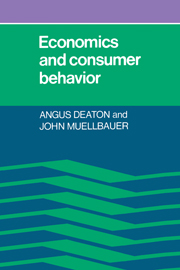Book contents
- Frontmatter
- Contents
- List of tables and figures
- Preface
- PART ONE CONSUMER DEMAND ANALYSIS
- PART TWO SEPARABILITY AND AGGREGATION
- PART THREE WELFARE AND CONSUMER BEHAVIOR
- PART FOUR EXTENSIONS AND APPLICATIONS
- 10 The quality of goods and household production theory
- 11 Labor supply
- 12 The consumption function and intertemporal choice
- 13 The demand for durable goods
- 14 Choice under uncertainty
- References
- List of notation
- Name index
- Subject index
13 - The demand for durable goods
Published online by Cambridge University Press: 05 June 2012
- Frontmatter
- Contents
- List of tables and figures
- Preface
- PART ONE CONSUMER DEMAND ANALYSIS
- PART TWO SEPARABILITY AND AGGREGATION
- PART THREE WELFARE AND CONSUMER BEHAVIOR
- PART FOUR EXTENSIONS AND APPLICATIONS
- 10 The quality of goods and household production theory
- 11 Labor supply
- 12 The consumption function and intertemporal choice
- 13 The demand for durable goods
- 14 Choice under uncertainty
- References
- List of notation
- Name index
- Subject index
Summary
Developing good theoretical models for applied work in economics is a difficult task and perhaps nowhere more so than in the modeling of the demand for durables, especially in aggregate time series data. On the one hand, a good model ought to be complete; on the other, the essence of a model is abstraction: choosing a small number of characteristics that are supposedly central to behavior. Abstraction is necessitated not only by the need to communicate ideas and information but by the limited discriminatory power of most aggregate time-series data. In the area of the demand for durables, a number of really very different and seemingly contradictory approaches have been put forward, and agreement is far from universal as to what are the central issues.
Perhaps the best way of seeing how complex are the problems is to begin by listing various themes or special features of the demand for durables, all of which have been emphasized by different economists working in the area.
(1) There is an extremely important distinction to be made between purchases, on the one hand, and consumption, on the other. Purchases are regarded as adding to stocks, while consumption, which is rendered possible by the existence of the stocks, is responsible for their depletion or physical deterioration. Although it is often assumed that consumption is proportional to the stock of the durable and that the latter physically depreciates at a constant, proportional rate, this is only one particular formulation.
[…]
- Type
- Chapter
- Information
- Economics and Consumer Behavior , pp. 345 - 379Publisher: Cambridge University PressPrint publication year: 1980



